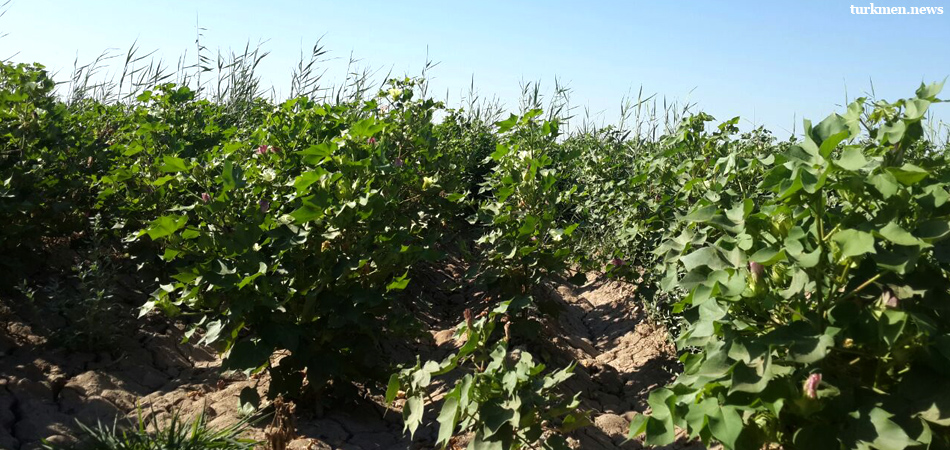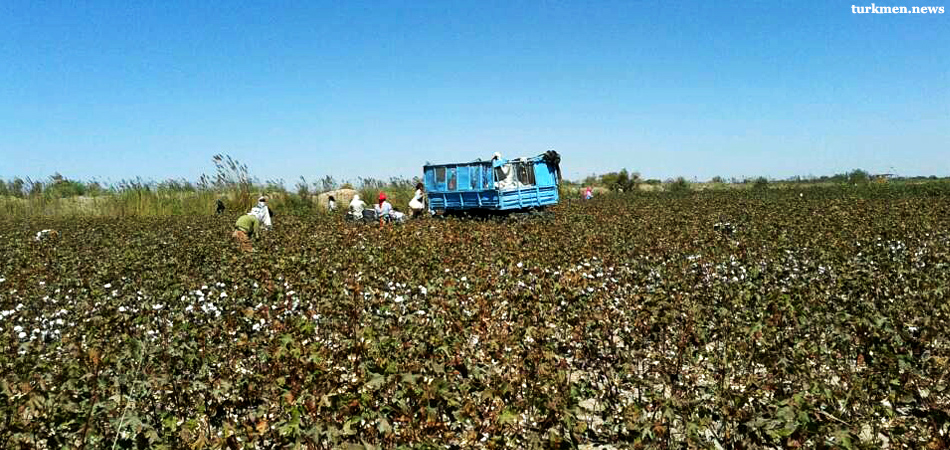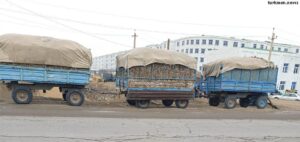
Turkmenistan: Longshoremen Sent to Harvest Cotton
19.10.2019
The cotton campaign is just coming to an end in Turkmenistan, but it’s already possible to say that the 2019 harvest has been very poor across the country. The cotton harvest continues to rely on forced labor, with increasing numbers of public sector employees having to pay to hire pickers to go to the fields in their place.
The key observations for the 2019 season are given below:

Throughout the 2019 season turkmen.news has reported instances of people from different professions being forced to pick cotton. Neither doctors, nor teachers, nor public utility workers, nor longshoremen, nor communications workers have anything to do with cotton. Nevertheless, in every state funded department employees are either torn away from their main work to be sent to the cotton fields, or told to hire pickers in their place or to give money to the management to find and hire replacement pickers. Coercion of public sector employees is systematic across the state, and this is evident from an audio recording (in turkmen.news’ possession) of a staff meeting at a Turkmenabat school.
The deputy principal told the meeting that the school principal goes to the education department every day, stands to attention there with other school and kindergarten principals, and comes back, his ears ringing from reprimands for the teachers’ failure to cope with the cotton harvest.
The instruction to send teachers cotton picking en masse in October, including during the fall break, came from the regional education department. According to the deputy principal, the deputy head of the education department, Kerim Masharipov, told the school heads that department officials are required to submit reports every day on how many teachers have been sent and how many tonnes of cotton they have harvested.
Turkmen.news is deliberately not publishing the recording in order to protect its observers. We have information that the special services are actively looking for those who report to us instances of city dwellers being forced to pick cotton. Members of the security agencies are under cover at the pick-up points for teachers, medics, and other public sector employees, and have their informants amongst the cotton pickers.
Turkmen.news has it on excellent authority that throughout the season similar staff meetings were held at kindergartens №1 and 6, schools №21, 29 and 31, at Halk Bank, Lebaptelecom and the general hospital. In the majority of cases money was taken from the employees to hire pickers. At Halk Bank the management hired a team of 25 people from a rural area. The hired workers picked cotton for the entire season instead of the bank staff, for which every staff member paid 800 manats ($45) from their own pocket, and that was the last they heard from the management about cotton. Throughout October people have complained to Lebaptelecom about poor connections, slow Internet and outages in cable TV. In the middle of the month people brought their routers to Lebaptelecom only to be told that there was no one to fix the Internet — almost the entire staff of the technical department, led by the deputy head of the enterprise, were away picking cotton.

It was a similar picture in other regions of Turkmenistan too. For the first time since 2014 state TV showed pictures of the cotton harvest in Balkan region, although they stopped sowing cotton in the region because of the poor soil and climate, and low yields. In the second half of October workers at Turkmenbashi maritime port were divided into several groups and sent on ten-day shifts to pick cotton in fields north of the town of Serdar. The workers had to pay for their own transport, food and accommodation. In the absence of any facilities at all, most people slept in the fields and ate the food they had brought with them. It was possible for the workers to buy themselves out of the trip, paying 300 manats ($17) to the personnel department (port director Annadurdy Kosayev had instructed the department to organize the workers’ trips to the cotton fields). Ordinary workers at the port are paid between 370 and 400 manats a month.
In Mary the chief doctor at the city maternity hospital, Juma Orazov, told employees to shell out 340 manats ($19) to hire people to pick cotton for 15 days. The head nurse was put in charge of collecting the money. The maternity hospital staff don’t know though whether the management really did hire people and, if so, for how much.
The practice of collecting money is universal in Mary region. Turkmen.news reported earlier that schoolteachers and other school personnel have to pay 240 manats ($13) to hire pickers at least twice during the season. Those who go to pick cotton themselves — there are fewer each time at the demand of the management — have been told they are being taken 90 km away from Mary to fields near the village of Kulanly in Oguzhan district. Money is also collected from public sector workers in the village itself. For example, at school №1 teachers paid 15 manats for every “cotton day.” As of October 22, every teacher had paid out 285 manats ($16).

While at the staff meeting in a Turkmenabat school teachers were asked to “show some understanding and help with the cotton,” the case was put more bluntly elsewhere: either agree to go cotton picking or to pay to hire someone else, or submit your resignation. Even though all the cotton in Ahal, Lebap and Mary regions had already been picked by late October, money is still being collected from public sector employees in Lebap and Mary and will continue to be collected until mid-November at the earliest.
The lack of victorious reports on the cotton harvest on the newswire of state agency TDH provides indirect evidence of the difficulties meeting the cotton plan this year. In any event, as of October 22 neither TDH nor Turkmenistan’s national TV had reported that any district, let alone region, had met the cotton production plan.
This is the state of play with the plan. In Mary region’s Karakum district the cotton plants were spindly and stunted across the sowing area because of a shortage of irrigation water and good quality fertilizers. The entire harvest has now been gathered in, with only bare red stalks left in the fields. The best tenant farmers had yields of just 15 centners of cotton per hectare, while the state plan was 30 centners. For approximately half the tenant farmers the yield per hectare was lower than 10 centners.
Farmer Geldimurat from Ak altyn village, for example, harvested a total of 32 centners of raw cotton from two hectares of land. He gives three reasons: a shortage of water for irrigation, a lack of fertilizers and equipment, and an infestation of agricultural pests.
This year cotton bollworm and beet armyworm have been the bane of farmers in Karakum district, and Mary region as a whole. The beet armyworm, also known as the tomato worm, has badly damaged the tomato, cabbage, pepper, and eggplant crop as well. According to the farmer, if officials do not artificially inflate the size of the harvest, as they do practically every year, then the harvest will be no more than 38-42% of the planned 1.05 million tonnes across the country for the reasons given above. The same problems mean shortages of vegetables in late autumn and winter are inevitable.
The provision of irrigation water, fertilizers, and agricultural equipment leaves much to be desired. In Karakum district just one tractor is available for 300 and more hectares. The district has no new equipment, and what it does have is old and always breaking down. It all belongs to the state and is assigned to an individual farmer who is obliged to maintain it in working order, buying spare parts and oil. Because of the shortage of tractors and cultivators some farmers in the district had to fertilize their fields by hand in the spring, which is a hellish job over several hectares. Other farmers did not fertilize their plots at all, as the tractor never arrived.
The quantity and quality of fertilizers supplied by the state do not suit the soil conditions. There is a shortage of phosphorous, which cotton plants need, and the quality of nitrogen is very low. The state set the necessary quantity of nitrogen at 375 kg per hectare of land, but that is very little, and the farmers cannot afford to buy additional nitrogen. The annual problem with irrigation water — there was a shortage in 2019 too — is exacerbated by the neglected state of the irrigation system. Irrigation channels, which should be dredged at least twice a year, are actually dug out once every two years. Sluices in a poor state of repair or even missing altogether on the main Durnalyyap irrigation channel in Karakum district lead to an erratic water supply to the farmers’ associations: some receive a lot, while others receive very little or none at all.
Ahal region has the same low figures for yield per hectare, but local farmers haven’t had problems with equipment. The main problem here has been a pest infestation. A photo sent from Tejen district shows cotton bolls attacked by cotton and tomato worms. The larvae eat the unopened bolls from the inside, and as a result the spoiled bolls do not open at all or open to reveal nothing inside. Fields attacked by the bollworm look very promising, but the plants are growing without fruit. The pest problem can be seen in Tejen, Babadayhan, Kaka and Sarahs districts of Ahal region, where most of the farmers’ associations will not meet the plan and will be fined.

Already, before the end of the harvest campaign, the management of the farmers’ associations and representatives of the local authorities of Ahal region are fining farmers for failing to meet their contractual commitments. The fines are equivalent to the purchase price of the cotton shortfall – 1,440 manats per tonne. Tenant farmers who are in debt to the state are borrowing money from relatives or fellow villagers or selling their cattle or vehicles.
Turkmen.news observers in Sarahs and Kaka districts have recorded dozens of cases of confiscation of land from farmers for failing to meet their cotton commitments. The farmers’ association takes away the land by simply tearing up the contract with the farmer. At the same time, the farmer is still obliged to pay the fine. Compelling the cotton growers to cover their shortfall out of their own pocket leads to an ever greater fall in the number of people wanting to lease land to sow cotton, and an ever greater number of tenant farmers giving up both their plots and working on the land. The tenant farmers say the work they put in is worth more than the money they receive for the cotton, but the 2019 season has driven even the most successful farmers into debt.
“The state will pay me 4,608 manats for 3.2 tonnes of cotton, but after compulsory payments have been taken I’ll probably receive around 4,000,” says tenant farmer Geldimurat from Karakum district. “But I won’t see this money either, as according to the contract I was supposed to have produced six tonnes of cotton. So the farmers’ association is already doing the paperwork to fine me for the shortfall of 2.8 tonnes — it will be around 3,800-4,000 manats. So I’ll finish the year with a zero balance sheet, and all my and my family’s hard work from early spring until late autumn will have been for nothing. There’ll be nothing at all for my family to live on in winter and spring.”
Tenant farmers say it’s unrealistic to produce a decent cotton harvest in the current conditions. This is why giving up on the land and emigrating to work in Turkey have become the alternative for most village families. Observers say that while labor migration used to be typical of the north and east of the country, today it’s difficult to find a family in the villages of the southern and southeastern Ahal and Mary regions in which someone doesn’t work in Turkey. In Ahal region’s Babayhan and Sarahs districts, and Mary’s Karakum, Murgap, and Sakarchage districts every family has someone working abroad.
The authorities are well aware of the difficult, if not critical, situation in agriculture. Decisions were taken in 2018 to correct the situation and stimulate the farmers’ associations to produce better end results. New state purchase prices were introduced for the 2019 harvest, an increase of 356 manats per tonne of cotton delivered before October 15. In addition, farmers were allowed to use 30% of the leased land to grow vegetables and cucurbits, feed and other crops.
However, even these steps have not changed the widespread trend of farmers refusing to lease state land. Why? Because with the devaluation of the national currency and increase in prices for agricultural services the increase in the purchase price for cotton has not had any impact on the income of tenant farmers. The decision to allow farmers to use part of their leased land at their own discretion has also fallen flat. Last year’s proposal from the People’s Council initially looked attractive, but farmers who decided to sow part of their land with vegetables came up against additional expenses: 300 manats to water the plot and 1,200 manats to use land to sow crops at their own discretion.
Tenant farmer Aydogdy from Tejen district sowed less than one third of his plot with tomatoes and watermelons. But it turned out in the fall that he hadn’t earned anything. The income from the sale of tomatoes and watermelons covered his losses from growing cotton. But even if the harvest had been good, the trickery of the supposed stimulus is that the state sets the plan for the individual farmer based on the overall size of his plot. If a farmer has three hectares of land and plants tomatoes on one hectare of it, he is still required to produce exactly nine tonnes of cotton at the end of the season, three tonnes per hectare. If he cannot, then he has to pay a fine, and make up for the losses, and if he doesn’t, then he’ll lose the land.
Turkmen.news and its observers in all the regions of the country, some of whom are experienced farmers from farming families, every year make a number of recommendations to the authorities to remedy the situation. Yes, modern equipment has been bought but it often doesn’t reach the farmers; yes, the government is looking for ways to stimulate the farmers’ associations to produce good harvests, but, as has been seen, the innovations hit the farmers harder in the pocket, forcing them to give up their tenancies and leave the country.
Turkmenistan needs cardinal reform of agriculture, including privatization of land and the departments providing equipment, fertilizers and pesticides to farmers. The problem of provision of irrigation water is becoming worse every year, so there needs to be a switch to drip irrigation everywhere, not only in parts of Baharden and Gokdepe districts of Ahal region. Until this is done, until the farmers themselves are interested in high yields from their work, the main problem of Turkmenistan’s cotton industry will not be solved – the use of the forced labor of tens of thousands of people who have nothing whatever to do with the production of this crop.

Petrofac Back in Favour in Turkmenistan After Falling Foul of Berdimuhamedov
18.03.2024

Murder and Suicide at Troubled Turkmen School
28.02.2024

Turkmen Prosecutor’s Office Claims Baloch Detainee’s Fatal Wounds Were Self-Inflicted
01.02.2024

Low Prices Lead Turkmen Farmers to Sell Cotton Harvest Residues for Fodder
19.01.2024

Young Man Tortured to Death by Law-Enforcement Officers in Turkmenistan (video)
21.12.2023
Tell us!
Add comment
your e-mail will not be published